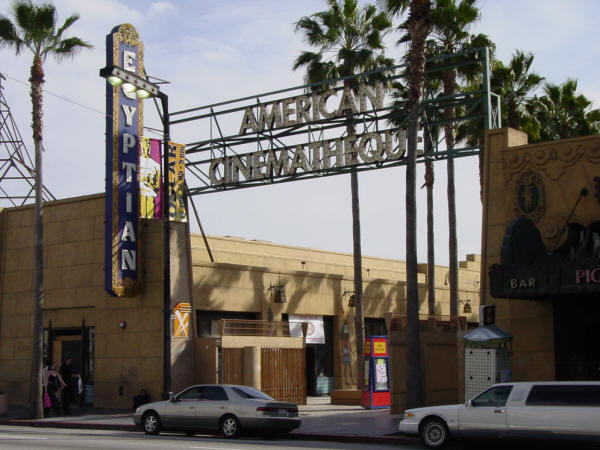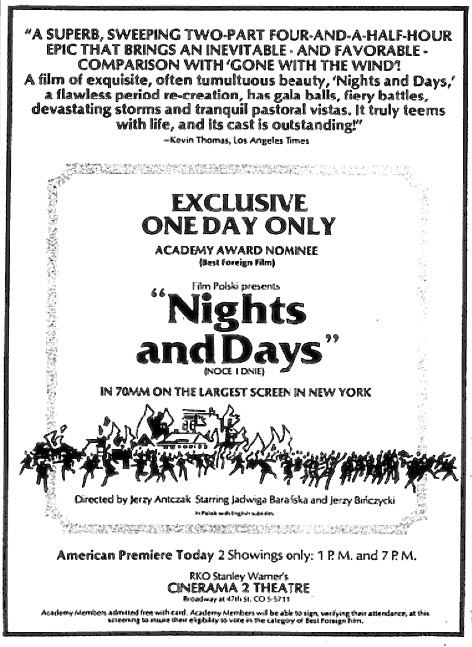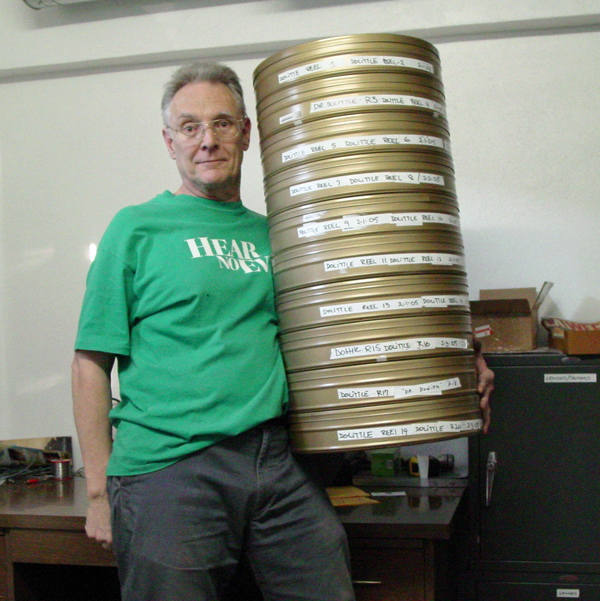Planning and Running the American Cinematheque's First 70mm Festival |
This article first appeared in |
| Written by: Paul Rayton, chief projectionist | Issue 59 - December 1999 |
 Egyptian
Theatre of the American Cinematheque in Hollywood, USA. Picture: Paul Rayton Egyptian
Theatre of the American Cinematheque in Hollywood, USA. Picture: Paul RaytonSoon after arriving on to the Chief Projectionist job (in May, 1999) at the Egyptian Theatre of the American Cinematheque, I began agitating for a series of 70mm films. Our main programmer, Dennis Bartok, was receptive to the idea, and I increased his interest by "happening" to remark about several of the films that had been shown in Europe in 70mm -- but which had never run that way in the States. (These include "Tomorrow Never Dies", "Armageddeon", "Godzilla", "Independence Day", "The Lost World", and even the reissued "Star Wars".) We are, of course, fortunate to be in the Los Angeles area, with all the nearby offices of the various film companies. Some are easier to deal with than others, but we must initially thank Columbia, MGM/UA, 20th Century-Fox, Universal, and Warner Brothers for their cooperation. They either allowed us to check prints for problems, or did some print checking themselves. In all instances, the prints had been from "earlier" years, and all had had varied histories of usage. Would they still be suitable for public projection? In late August, over two months before the first public shows, we began evaluating various prints for any technical problems. We had especially good cooperation for this from, as mentioned, WB and MGM/UA. We looked at selected reel(s) of several of their potential films, looking for color (fading) problems, and sound problems. I am dearly in love with magnetic analog sound, but the tracks, unfortunately, can sometimes tend to pick up noise problems as the years go by... We made notes about sound noises, and I also applied a personal and very subjective letter grade (from "A" to "D", D being worst) to the color quality fading) of the print. For example, from Warner Brothers, we evaluated "The Wild Bunch" [Restored] and approved it for showing, despite some minor noise in some of the tracks. It being a relatively recent (and "restored") print, I didn't give it a color grade. One colleague, however, said he had seen another print from the same batch of prints and thought somehow that the other print had been better. I don't know. But no one complained when we ran it! We also appraised WB's "Jeremiah Johnson", but had to omit it because it was a bit too faded. I gave it a "C-" grade. And having to omit that film was really a shame - the print was absolutely mint: I think my fingerprints on the leader were the only ones since the film was released in 1972! The sound was fabulous. But the picture was irretrievably faded. So, we had to let that one go by. It even had the complete ±4 minute overture at the beginning, which means, I've been told, that it was a European print, or at least a print made for European distribution. Apparently, our domestic prints did not have the overture & intermission music! We also checked out WB's "Batman". The only reason for not booking it was a lack of programming time. I rated its color as "B+" Similarly, we could not accomodate "Superman", but that one was (according to my notes) "significantly faded". (C) From MGM, "Chitty Chitty Bang Bang" was also looked at. It was really faded (I gave it a "C-" in my notes), but it looked so grand, since it was so sharp.... And the sound was magnificent. What were we to do? If we ran it for a paying audience, they might complain that it was "too faded".... But it was so unique and clean...! What to do? We decided to run it for free, as a "public service", first for people who might want to bring their kids to a 70mm showing of a classic childrens movie, and secondly as sort of an appeal to Hollywood to not let all these old classics fade away without at least a final attempt to re-print them on to modern, less fade-prone, print stocks. |
Further in 70mm reading: |
 In addition to USA-originated films, there are several non-USA films that are available locally as part of the AMPAS* collection. One of those, Jerzy Anczak's 1975 Polish film
"Nights & Days: Bogumil & Barbara" was shot in a large-format process. It was of additional interest to us because the lead actress (Jadwiga Baranska) now is living here in the L.A. area. It would have been fun to run this film and have her appear afterward for a Q&A ("question & answer") session. In addition to USA-originated films, there are several non-USA films that are available locally as part of the AMPAS* collection. One of those, Jerzy Anczak's 1975 Polish film
"Nights & Days: Bogumil & Barbara" was shot in a large-format process. It was of additional interest to us because the lead actress (Jadwiga Baranska) now is living here in the L.A. area. It would have been fun to run this film and have her appear afterward for a Q&A ("question & answer") session. And we evaluated a few reels of "War and Peace", from the Soviet Union. It was an original print, from 1968, printed on Orwo stock, the film stock from Poland. The colors were slightly faded, but overall really excellent. That comparison could be kind of embarrassing if you were from Eastman Kodak Co. and we were comparing equivalent Eastmancolor prints from the same era! There is also another film from Poland, a film from about 1974 called "The Deluge". This one appeared to be a blow-up, but the color and sound were both in good condition. In the end, we decided that, again due to lack of programming time, we'd only run one eastern European "epic" production, and thus we selected the slightly more famous "War and Peace". We also did some print comparisons. For "The Sound of Music", we had two different prints locally available. One was the Twentieth Century-Fox "studio" print. The other was the print from AMPAS. Both prints appeared to have been made at the same time, about 1991, based on the date codes of the print stock. (Later reports told us that these two prints were made on the occasion of the 25th anniversary of the film.) Initially, we checked the Fox studio print. It had been circulated to "commercial" cinemas and was scratched, splicey, and somewhat noisy. Not so good. The AMPAS print was much better. It wasn't perfect, mind you, but very good. Sound tracks mostly noise-free. Colors mostly well matched. Few problems with scratches. That's what we ran, and the audience [and we projectionists!] loved it. The director, Robert Wise, was in the audience and answered questions after the film. On the leader of reel #10 of "The Sound of Music" we discovered a showmanship hint from some previous projectionist. The wedding sequence does have a really impressive recording of some pipe organ music. We didn't knock down our wals with excessive sound, but the hint on the leader was a good idea. If this film is ever re-released as a "digital sound" version , I hope they use the "special venue" DTS processor, which allows presentation of all 5 stage channels! Meanwhile, John Kirk of MGM/UA sought out and had shipped to the States their "recent" 70mm film for which they had performance rights. That was how "Tomorrow Never Dies" (70mm/DTS) reached our shores. It had been somewhere in Italy. [the overseas distribution of films is often assigned to different companies than domestic distribution rights] Later on, preparing "Tomorrow Never Dies" for our projection run, I lost some of my generally high respect for European projectionists: reel #5 was received with the "heads" and "tails" reversed, and the reel would have been upside down and backwards had I not noticed and corrected the problem! I was really shocked to receive a print thus screwed up, considering the higher standards I've generally seen prevailing among European projectionists! And I'm really happy we caught it before we went on screen with it! And we might also thank Michael Schlesinger of Columbia Pictures Repertory division. He located and brought over from Europe the print of "Godzilla". That one had been located in England, after a run in Germany. Finally, it came time to run the films. Some lived up to their reputation, some did not. "Spartacus" looked decent, though I think it was printed from a duplicate negative. "Lawrence of Arabia" was the "restored" version (circa 1991), which also appears to be from a later-generation copy negative and seems somehow more grainy than I remember it in the original... The prints of "The Sound of Music" and "Oklahoma!" were fine, obviously printed from the "original" source materials. "Oklahoma!", from the date codes on the print stock, was printed in about 1982. That date was coincident with a revival of the film. "Baraka", the newest feature we ran, was the personal print of the film's producer and was simply awesome (even with a bit of noise in some spots of the tracks). Every bit as good as Imax, without that format's boxy 3x4 screen ratio. Images simply glowing on the screen. "The Road Warrior" was faded and noisy, but it's an action film and the audience tended to forgive those faults since it's a high-energy film and the screen is full of visceral excitement. |
|
 Paul
Rayton, Chief Projectionist, Egyptian Theatre in Hollywood, USA Paul
Rayton, Chief Projectionist, Egyptian Theatre in Hollywood, USAI'd had little experience with these 70mm/DTS feature prints (since most American exhibitors are too blind to seek out such prints!). "Tomorrow Never Dies" was obviously a blow-up, but it sure looked good on our big screen! The same was true for "Godzilla". "Tomorrow Never Dies" had some annoying dust spots (caused by print "shedding") that were reluctant to come off the print, even with an attempt to clean it with velvet cloth. "Godzilla", by contrast, was quite clean for the entire length. And "Titanic" - what can I say? Everyone (almost) has seen it; and it is certifiably better in 70mm, even as a blow-up from Super 35. No question. I was happy to see that both "Tomorrow Never Dies" and "Godzilla" were printed "full aperture", meaning that the image filled the available picture area, sprocket hole-to-sprocket hole. That gives you extra picture width on the screen (which previously was not available because of the magnetic sound track occupying the area) and makes the resulting ratio closer to the 35mm CinemaScope/Panavision ratio of 2.35:1. Great! Wider screen 70mm!! The mystery was "Titanic", which was printed with black borders along the left and right edges! All future blow-ups should be done to full-aperture dimensions! Attendance was generally quite good. The weakest show was "Godzilla", which was perhaps to be expected since the film was not all it could have been and was roundly criticized by true Godzilla devotees... We had several shows that were near or total sellouts, and we will likely consider them for repeats at our next 70mm extravaganza ("Coming in 2000"), including "Lawrence of Arabia" and "Apocalypse Now". It was a lot of work, but worth the effort. I'm aware of only one missed changeover in the entire series, which means that most everything ran quite well. That in itself is a miracle when dealing with older prints. Even all 24 reels of "War and Peace"! *AMPAS = "Academy of Motion Picture Arts & Sciences" (the Motion Picture Academy, which hands out the Oscars each year. They also maintain a historic library of nominated and/or winning films). The years cited are the years those films were considered for "Oscar" awards, which may be different calendar years than the films were originally released in their home countries... |
|
| Go: back
- top - back issues Updated 21-01-24 |
